8 Days UNESCO World Heritage Site Tour of Korea



Take the UNESCO World Heritage tour and be amazed by Korea’s major cultural and natural heritage sites on UNESCO’s World Heritage List. You will gain a broad and deep understanding of Korean culture and tradition in a short amount of time.
* Minimum 2 persons are guaranteed to depart every Sunday.

Day 1
Jeju Volcanic Island
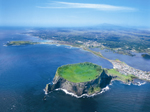
Jeju volcanic island and lava tubes are listed by UNESCO as having outstanding natural significance to the common heritage of humanity. Jeju Island is the premier tourist destination in Korea because of its stunning natural scenery and superior tourist amenities. Scenic beaches, waterfalls, cliffs and caves exist in harmony, while the mild weather makes Jeju Island an even more ideal tourist site.
 Upon arrival in Jeju you will be met by a tour guide. Your tour guide will first take you to the Jeju Folklore and Natural History Museum where you can see and experience a traditional thatched house in the local style, local crafts and folklore, as well as flora, insect and marine displays. Then you will visit Yongduam Rock (or Dragon Head Rock), a rock formation created by a volcanic eruption two million years ago. At 10 meters high and 30 meters long, Yongduam Rock is aptly named because its shape resembles a dragon’s head. Optional tour: Pony Show ($13 USD).
Upon arrival in Jeju you will be met by a tour guide. Your tour guide will first take you to the Jeju Folklore and Natural History Museum where you can see and experience a traditional thatched house in the local style, local crafts and folklore, as well as flora, insect and marine displays. Then you will visit Yongduam Rock (or Dragon Head Rock), a rock formation created by a volcanic eruption two million years ago. At 10 meters high and 30 meters long, Yongduam Rock is aptly named because its shape resembles a dragon’s head. Optional tour: Pony Show ($13 USD). Day 2
Jeju Volcanic Island
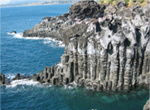
Today the tour will take you to Jusangjeolli Cliff on the Daepo coast, a spectacular 2 km stretch of coastline with the prominent feature being hexagonal rock pillars, extraordinary rock formations produced from the rapid cooling and contraction of lava. Next you will visit the Yongmeori (or Dragon Head) Coast – an impressive and beautiful oceanside promenade of soaring, weather-blown cliffs. Note that Yongmeori closes during very high seas. If this is the case during your visit, you will instead visit Sangbanggulsa, a natural cave with fantastic views over the ocean. The tour continues to Spirited Garden Bunjae Artpia, the world’s largest botanical garden that is rich with trees nearly 300 years old as well as a variety of maple trees, wisterias and pine trees. It also boasts nearly 100 types of rare trees, 10,000 Jeju wild flowers, orchids and other various garden plants that together form a unique scenic harmony. Optional tour: Gyulimseong (Jeju’s indigenous tangerine farm) and Cruise (USD 17). On this optional tour, you will enjoy breathtaking scenery both on and under the sea, viewing beautiful secluded islets and waterfalls.
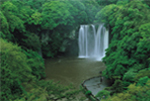
You will experience the beauty of Cheonjeyeon Waterfall, a three-tiered waterfall also named "the pond of God." Here the water from the first waterfall flows into a pond that pours into the second and then the third waterfall, and then flows into the sea. Next on the optional tour you will visit Yakchunsa, the largest Buddhist temple in Asia that features an 18-ton bell. It is a renowned place of worship and magnificence where Buddhists - and tourists - pray for their wishes to come true.
Day 3
Jeju Island > Busan > Ulsan

Today you will check out of your hotel and begin the day’s tour at Tokkaebi Road (Mysterious Road) – a road on which your vehicle will strangely roll uphill if it is parked and in neutral. The tour continues at the Amethyst Factory and shopping center where you can find excellent quality Korean amethyst stones. Manjanggul Cave is the next stop on the tour. This UNESCO World Heritage Site is one of the finest lava tunnels in the world. With a variety of interesting natural rock formations inside, it was created when lava deep in the Earth spewed out to the surface.
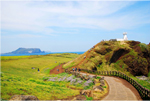
Next you will visit Seobjikoji, located at the end of Jeju Island’s eastern shore and renowned for its stunning coastline views. Here you will see green fields without a single tree spread beyond the cliff and rocks, as well as stone walls hugging the road as they lead to a lighthouse.

Next you will transfer to Jeju International Airport and fly to Busan (Gimhae) Airport. Upon arrival, your tour guide will meet you and drive you to downtown Busan. Busan is the second largest city in Korea and is surrounded by mountains and the East Sea. You will explore Jagalchi Fish Market, the largest seafood market in Korea. Built after the Korean War (1950~1953), Jagalchi is a fish market where you can experience the lifestyle of the Busan locals. The tour will continue to Yongdusan Park, a favorite park with local residents that supports 70 different kinds of trees and also features Busan Tower. Next you will drive to Ulsan City, well known for Hyundai Motor Company and Hyundai shipyard, one of the largest shipyards in the world. You will end the day by checking in at the Hyundai Hotel in Ulsan
Day 4
Ulsan > Gyeongju > Haeinsa Temple
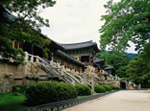
This morning you will check out of your hotel and take a stroll through Songlim (or Pine Tree) Park near Daewangam Rock on the eastern coast. This location is where King Munmu of the Shilla Dynasty (57 BC ~ 935 AD) died to be a dragon in defense of his motherland from Japanese invasion. Next, the tour will take you to the city of Gyeongju, a museum without walls. In 57 BC, at the time when Julius Caesar was subduing Gaul, Gyeongju became the capital of the Shilla Dynasty and remained so for about 1000 years.
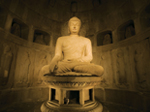
Gyeongju preserves a large number of significant and fascinating historical and cultural sites, and has been designated a World Heritage Site by UNESCO. On the tour, you will visit Gyeongju National Museum, Cheomseongdae Astronomical Observatory and Seokguram Grotto, an artificial stone temple made of granite located on the eastern peak of Mt. Toham. Seokguram Grotto was built to preserve several statues, including Bonjon Statue as well as statues of Bodhi-Sattava and disciples, found inside the round-shaped main hall. Next you will move to Bulguksa Temple, a temple of splendid artistic beauty that is highly praised by visitors from all over the world. The last stop on the tour today is Gayasan National Park.
Day 5
Haeinsa Temple > Andong > Mountain Seorak
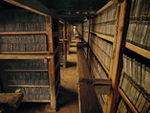
After you check out in the morning, you will begin the day’s tour at Haeinsa Temple located in Gayasan National Park. Haeinsa Temple was founded by King Ae-Jang of the Shilla Dynasty (in 802 AD), and is well known for its famous treasure: the “Tripitaka Koreana.” This UNESCO World Heritage Site consists of 81,341 printing woodblocks made to repel the Mongolian army invasion with support of the Buddha.

Afterwards, you will visit Andong Hahoe Village. This village dates back to the Joseon Dynasty and has retained and preserved the original architecture of the housing structures. This World Heritage Site became famous after Queen Elizabeth II of Great Britain visited the village several years ago. The last stop on the day’s tour is Sokcho, a busy port filled with fishing boats and commercial ships. Then you will check in at your hotel located close to the Sokcho seashore.
Day 6
Mt. Seorak > Seoul
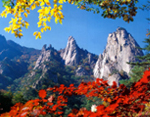
The tour will begin at Mt. Seorak National Park. Here tall mountain peaks break through the clouds and jade-like water flows through the valleys, creating breathtaking views and making this Korea’s most famous national park. UNESCO designated this park a Biosphere Preservation District in 1982 due to the many rare species of flora and fauna found in the area. Next you will visit Sinheungsa Temple, an ancient temple built by the great monk Jajangyulsa (590 AD ~ 658 AD) on Mt. Seorak. Optional Tour: Gwongeumseong Cable Car ($15 USD). Here you can see Gwongeumseong Castle on the steep Dol Mountain of Mt. Seorak National Park. After sightseeing at Mt. Seorak National Park, you will continue to Seoul and check in to your hotel.
Day 7
Seoul > Hwaseong > Seoul
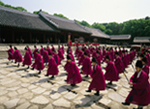
Today you will begin the tour with a visit to Cheongwadae (the presidential residence) and Jongmyo Royal Shrine. The shrine, a UNESCO World Heritage site, was the place of worship for the kings of the Joseon Dynasty (1392 ~ 1910). It is well known for its 600-year-old ritual ceremonies linking music, song and dance that continue to this day. Next you will tour Changdeokgung Palace. This UNESCO World Heritage Site served as the primary palace for Sejong, the ninth king of the Joseon Dynasty. The palace compound includes a public palace area, the royal family residence and the rear garden, which has been kept in its natural, wild state.
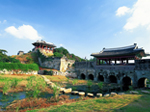
You will continue to Hwaseong Fortress, a UNESCO World Heritage Site located in Suwon City, a one-and-a-half hour drive south of Seoul. Hwangseong Fortress was built by King Jeongjo of the Joseon Dynasty in 1796. Interestingly, the fortress was built using both stone and brick, and a system of pulleys was used to lift the heavy materials and reduce construction time. While most structures of this size and stature during this era took nearly 10 years to build, the ingenious pulley system reduced the construction time to a mere 33 months – a pioneering achievement!
* Evening Optional Tour 1 - Traditional performance: $35 USD
* Evening Optional Tour 2 - NANTA performance: $50 USD
Day 8
Seoul
Today is the last day of the tour. After breakfast at your hotel, you are free to explore the fascinating city of Seoul on your own.
Meal:
Breakfast
* Photos courtesy of Korea Tourism Organization and visitseoul.net.
* The cost of the tour includes: Hotels / Guides / Transportation / Meals (as indicated in the itinerary) / Entrance fees.
* The cost of the tour does not include: International and domestic flights / Travel insurance / Optional tours / Dinner / Tips for the guide and driver ($10 USD per person per day is recommended) / Personal expenses.
Terms and Conditions
- Prices may vary due to availability. We reserve the right to make price adjustments without prior notice.
- Although it is our strong intention to follow the agreed itinerary, there will be a degree of flexibility in consideration of various operational factors including flight delays or bad weather.
- Please refer to our Terms and Conditions before you make your reservation.
- Although it is our strong intention to follow the agreed itinerary, there will be a degree of flexibility in consideration of various operational factors including flight delays or bad weather.
- Please refer to our Terms and Conditions before you make your reservation.

